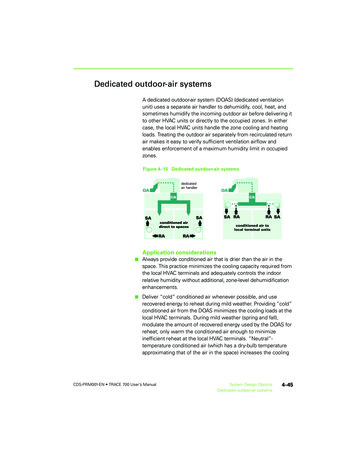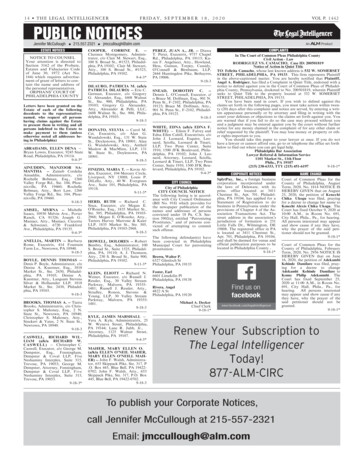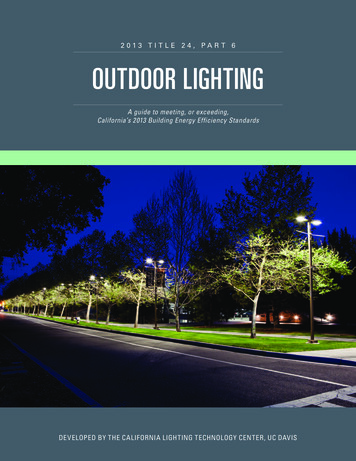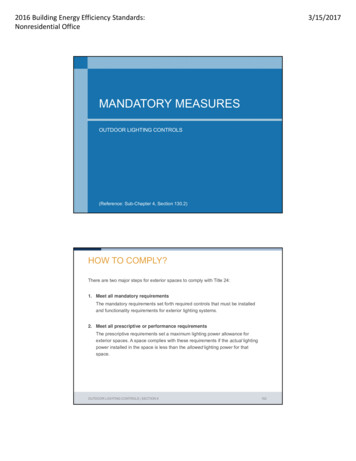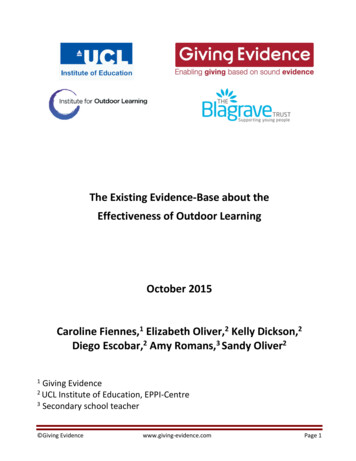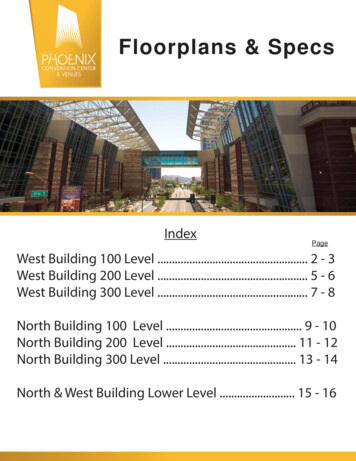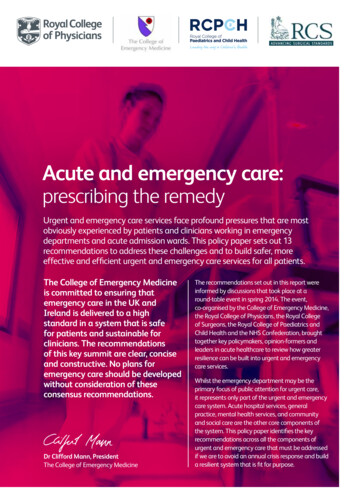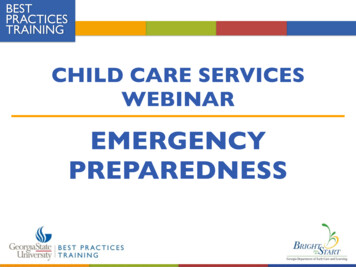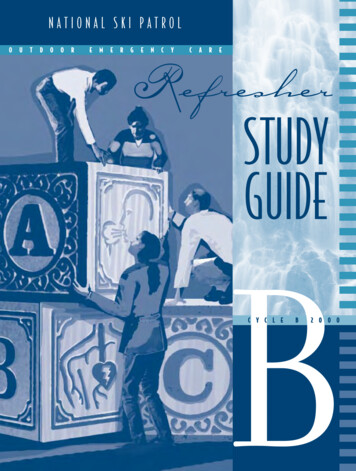
Transcription
NATIONAL SKI PATROLOUTDOOREMERGENCYCARERefresherSTUDYGUIDEBC Y C L EB2 0 0 0
INTRODUCTIONNEW MILLENNIUM—CONTINUING EXCELLENCEAs the National Ski Patrol enters the new millennium it retains the same focus that inspired its formationmore than 60 years ago—helping those who become ill or injured on the slopes. In large part, the enduring strength of this commitment is a reflection of you, the individual patroller, whose perseverance anddedication are the backbone of the association. Your willingness to assimilate new programs and growwith the changing concepts in emergency care ensures quality management of patients and helps preservethe NSP’s reputation as a leading provider of outdoor-oriented emergency care.The fall refresher reinforces Outdoor Emergency Care procedures and bolsters patrollers’ confidencein their patient-care skills. And because participants have to go through this process every year, refreshersmust be consistently interesting, challenging, and imbued with enthusiasm with regard to the informationthat’s passed along. Judging by the evaluations submitted by refresher attendees in recent years, thisapproach is very well-received. Keeping this in mind, the OEC Refresher Committee has tried to developa Cycle B refresher format that’s efficient, reflective, thought-provoking, and fun.Committee members are aware that spending a full day reviewing emergency skills and assessmentprotocols can be a challenge. Please keep in mind that the committee has put a lot of thought and creativeenergies into the 2000 refresher, and the only thing it asks in return is that you continue your commitment to quality emergency care. Prepare for the refresher by reading the OEC-oriented articles in thisissue of Ski Patrol Magazine and carefully reviewing the materials in this Refresher Study Guide. The brieftime you spend in preparation will be rewarded ten-fold by the satisfaction and personal confidence you’llgain from having thoughtfully completed this important exercise. Have a great refresher as well as a safeand fun 2000–2001 season!ONLINE OPTION ON TAPTO MAKE STUDYING EASIERNSP members will soonbe able to purchaseNSP’s first-ever interactivestudy tool designed tohelp them prepare for theannual Outdoor Emergency Care (OEC)refresher. Scheduled forrelease by August 1,2000, the OutdoorEmergency Care OnlineReview is intended tomake studying for theOEC refresher both stimulating and productive.The Online Review,which is currently indevelopment, will helppatrollers evaluate theirmastery of material foundin the third edition ofOutdoor EmergencyCare and the OECRefresher Study Guide.This interactive studytool is being designedto offer patrollers anopportunity to renewand demonstrate competency in required OECknowledge and skillsfrom home or elsewhere.Each topic and scenario to be covered in thisfall’s refresher will besupplemented by 20 to40 multiple-choice questions, which patrollerscan access online to testtheir knowledge of keyconcepts and proceduresbefore attending theirrefresher. The programwill also include aninstant grading feature toprovide immediate resultsas well as brief explanations of the answers forall questions. With resultscontinued on page 3OEC REFRESHER PROGRAMJUST THE FACTS, PLEASEThe OEC refresher program provides NSP members with a continuing education opportunity torenew and demonstrate competency in requiredOEC knowledge and skills while using a variety ofequipment and techniques.Refreshers are based on performance, not time.This allows patrollers to work at their own pace tomeet specific knowledge and skill objectives.Activities will focus on performance criteriawith immediate, constructive feedback included asa part of each section. For those whose knowledgeor skills can benefit from further study or practice,additional or remedial education will be available.The value and success of the refresher dependson the commitment displayed by each participant,including all members of the OEC RefresherCommittee, the NSP patrol representatives, theinstructor trainers (ITs), the instructors, and you—the individual patroller. Think of everyone involvedas being part of one big quality assurance team.Refresher quality can be guaranteed only if all members of the team willingly and enthusiastically agreeto dedicate themselves to the refresher process.2000 REFRESHER STUDY GUIDEn2n To maintain membership in the organizationfor the upcoming ski season, NSP membersmust successfully complete the annual OECrefresher. The only members exempt from thisrequirement are those registeredcandidate patrollers who are enrolled in anOEC course, those members who completeda full OEC course after May 31 of the currentcalendar year, and those members who areregistered as medical associates.A refresher is not the equivalent of a professional challenge for a candidate patrollerentering the NSP system with previousemergency care or medical training.A patroller who wishes to renew active statusfrom an inactive registration or a missedpatrolling season must1. complete the refresher cycle(s) missedduring the inactive period (only thosepatrollers with a valid OEC certificationmay renew active status), and2. pay national dues for each inactive year.SKI PATROL MAGAZINE
HOW TO PREPARE Allow yourself plenty of time to study theOutdoor Emergency Care references listed inthis study guide for Cycle B. Please note thatall references are to the third edition of OEC.After studying these references, review theobjectives presented with the refresher topics.Then answer the questions for each scenariofound in the Scenario Discussion Forumsection of this study guide. (You may find ithelpful to cite text references in the spaceprovided.) Be sure to bring the completedstudy guide to the refresher.Use the skill performance guidelines in thisstudy guide and in the third edition OECStudy Book to review and practice the skillsyou will be asked to demonstrate during thisyear’s refresher.Check with your patrol or region to determinewhen and where the refresher will be held. Ifyou have a conflict, contact the OEC regionadministrator for an alternate date. Do not waituntil the last minute to do this. It is yourresponsibility to find out when the refresheris being held.Review and follow local instructions withregard to study, review, information references,and refresher logistics.REFRESHER FOLLOW-UP CPR AND AED POLICYA.B.WHAT TO BRING TO THE REFRESHER This 2000 Refresher Study Guide. Rememberto complete your written answers to thescenario text and action questions beforeyou arrive.Your current OEC, CPR, and NSP registration cards. (You may obtain a duplicateOEC card from the national office by mailing a check or money order for 4 madepayable to NSP, 133 S. Van Gordon St.,Suite 100, Lakewood, CO 80228. Enclosea note asking for a new OEC card and allowthree to four weeks for delivery.)A fully stocked aid belt, vest, or pack andany additional items required at the refresheryou will be attending. Dress appropriately toparticipate in both indoor and outdoorrefresher activities.SKI PATROL MAGAZINEComplete and hand in the “Patroller Evaluation for the 2000 OEC Refresher” found inthis study guide.If you attend another region or patrol’s refresher,be sure the instructor of record has all thenecessary information to verify your completion of the refresher to the national office ona supplemental roster. The roster must includeyour NSP membership I.D. number, name(as it appears in national registration records),patrol identification, and address. You may alsowant to use the verification form at the end ofthis guide to document your attendance toyour patrol representative.C.D.All active NSP members must hold a currentprofessional-rescuer CPR certification fromthe American Heart Association, the AmericanRed Cross, or the National Safety Council.This must include training in two-rescuerCPR techniques.All active NSP members must demonstratetheir CPR skills each season, regardless of thecertifying agency’s requirements or the expirationdate of the card. The National Medical Committee stresses the importance of participatingin this CPR skills refresher because repetitionand practice help develop competency. A newcertificate need not be issued by the certifyingbody unless the certificate expires before thestart of the upcoming ski season.CPR training may be completed in an independent patrol session, accomplished by eachpatroller on an individual basis, or included asa part of the OEC refresher. If CPR trainingis conducted in a patrol session or at an OECrefresher, organizers must allow appropriateCPR review time and use the instructionalstandards for updating cardholders providedby the chapter or affiliate in accordance withguidelines established in the Journal of theAmerican Medical Association, October 1992.With regard to the use of automated externaldefibrillators (AEDs), the American HeartAssociation recommends AED training forrescuers who respond to incidents in high-riskenvironments. At this time, AED concepts areincluded in most CPR courses. AED skillsn3ncontinued from page 2of the review in hand,patrollers will be able toreduce their training timeat their local refreshersthis fall. In addition, theprogram will providepage references to theOutdoor EmergencyCare text and hyperlinksto other medical sitesfor those who wish tolearn more about specifictopics.The OEC OnlineReview will be found atwww.nspoec.com. Onceat the site, NSP memberswill simply click on theOutdoor Emergency CareOnline Review tab andpurchase access to thesite for a one-time chargeof 9.95 (via a secure,encrypted order form).The member will thenhave access to the program for six months fromthe date of purchase.The OEC Online Reviewis the first product offeredthrough an exciting newrelationship between theNSP and Jones andBartlett Publishers (J&B).For each unit of thereview sold, J&B willpay a royalty to NSP tobenefit the organization’seducation programs.The NSP and J&B havealso partnered to developthe fourth edition ofOutdoor EmergencyCare. This alliancepromises to foster thedevelopment of manynew methods of delivering OEC materials—including electronicteaching tools—to helppatrollers enhancetheir skills.2000 REFRESHER STUDY GUIDE
training, where provided, is taught as an addon option in citizen-level and professionalrescuer courses. Patrollers are reminded thatthey must obtain ski area managementTHE TOP 10 REASONSWHY PATROLLERS CAN’TWAIT TO GO TO THEIRREFRESHERSapproval to practice with and use AEDs.Furthermore, any such use must be conductedin accordance with statutes and protocolsestablished by state and local authorities.OEC REFRESHER TOPICS AND OBJECTIVES10.Since the grass isalmost done growing,they really have nothingbetter to do over theThe six core topics that follow are essential subjects and skills that apply to all emergency care situations.Patrollers must review and demonstrate proficiency in all core subjects each year.A. CORE TOPICS AND OBJECTIVES1.weekend.Shock Management (2000 focus area) 2.Cold-Injury Management (2000 focus area) 9.For weeks, they’vebeen looking for a good excuse to get up at thecrack of dawn.8. They enjoy running3.around aimlessly at 8 in 4.tend to remember this yesterday.5.They get 6.there.The coffee, tea, and Demonstrate the ability to recognize patients with head and/or spinal injuries.Integrate the application of spinal immobilization techniques and devices in other refresherscenarios and stations.B. GENERAL TOPICS AND OBJECTIVESdonuts alone are worth1.the drive.5.Demonstrate the correct application of body substance isolation (BSI) to minimize exposureto body fluids in all applicable patient care situations.Neurological Injury Management 6.Demonstrate assessment techniques for an injured person, using the Patient Assessment—Rapid Body Survey and Patient Assessment—Responsive—Injured (Trauma) skillperformance guidelines.Infection Controlpaid so wellfor beingDemonstrate airway management techniques and the correct application and use of airwayadjuncts, oxygen administration, and suction equipment.Patient Assessment: Rapid Body Survey, Focused Trauma Surveystuff like they did it just7.Provide an in-depth review of the body’s heat production mechanism, hypothermia, and otherillnesses and injuries related to the cold environment.Be able to recognize and discuss the signs and symptoms of cold-related injuries, includinghypothermia.Demonstrate techniques to manage patients with hypothermia or other cold-related illnessesor injuries.Airway Management and Oxygen Administrationthe morning with dozensof other people who pre-Provide an in-depth review of the anatomy and physiology of the circulatory system, as well asthe different types of shock, their causes, and emergency treatment.Be able to recognize the potential for shock and its signs and symptoms.Demonstrate techniques to prevent and manage shock.a.They can sit,b.crammed together, inone guy’s car and dothe written part of theRefresher Study Guideon the way to theski area.2000 REFRESHER STUDY GUIDEAnatomy and Physiology2.Circulatory system—List and be able to describe the major structures and functions of thecirculatory system and how it interacts with other body systems in health, disease, and injury.Cutaneous system—List and be able to describe the major structures and functions of thecutaneous system and how it interacts with other body systems in health, disease, and injury.Orthopedic TraumaUpper-extremity injuries, injuries at or near joints, and open fractures—Describe the signs and symptoms and principles of emergency care for upper-extremity injuries. Review the mechanism andpattern of upper-extremity injuries, injuries at or near joints, and open fractures. Using the applicable skill performance guidelines, demonstrate the proper assessment and correct application ofvarious immobilization techniques and devices for the shoulder, upper arm, elbow, forearm, wrist,and hand. Demonstrate the correct management of injuries at or near a joint. Demonstrate thecorrect management of an open fracture before and during immobilization.n4nSKI PATROL MAGAZINE
3.4.Environmental and Medical EmergenciesEnvironmental injuries—List and describe the injuries and illnesses caused by the environmentalfactors listed below. Describe the causes, signs and symptoms, and essential emergency care for each.a. Coldb. Heatc.Altituded. Solare. Electricalwhat goofy things theSpecific Injuriesinstructors are going toa.b.c.5.4.Bleeding—Demonstrate techniques for managing and controlling external bleeding and allsoft-tissue injuries.Burns—Demonstrate essential emergency care for thermal burns.Bandaging—Demonstrate general bandaging techniques.They can’t wait to seehave them do at thestations this year.Transportation and ExtricationPositioning patients—Review the advantages and disadvantages of positioning, lifting, and/or moving a patient using the three positions of “jams and pretzels.” Demonstrate each of these positions,using the correct technique.6.Local NeedsReview applicable local requirements, topics, and equipment related to the performance ofoutdoor emergency care at the patrol level. The OEC instructor of record reviews these conceptswith patrol officers and the medical advisor to determine how to integrate applicable techniquesor equipment into the current OEC refresher.Specific area emergency care training may be accomplished at this time, including AEDskills training as appropriate. Organizers may need to lengthen the overall refresher program toadequately cover these subjects. This objective is not to be confused with additional local trainingfor patrol operations, such as lift evacuation, commonly referred to and accomplished in aseparate on-the-hill refresher.STUDY REFERENCESOEC TEXT AND STUDY BOOK, THIRD EDITIONShock Management (focus area)Cold Injury Management (focus area)Airway Management and Oxygen AdministrationPatient AssessmentInfection ControlNeurological Injury ManagementChapter 7Chapter 19Chapter 6Chapters 4, 5, 20, and 21(Chapter 20 is included as a referencefor pediatric assessment.)Chapter 4 and Appendix FChapters 13 and 14GENERAL TOPICSOEC TEXT AND STUDY BOOK, THIRD EDITIONAnatomy and PhysiologyCirculatory SystemCutaneous SystemOrthopedic TraumaUpper Extremity Injuries, Injuries At orNear a Joint, and Open FracturesEnvironmental and Medical EmergenciesEnvironmental EmergenciesSpecific InjuriesControl of Serious Bleeding, Burns, BandagingExtrication and TransportExtrication from Difficult Positions,Jams and PretzelsChapter 2Chapters 9, 10, 11, and 12They heard a rumorlooking patrol representative has volunteered tobe a patient for therapid body grope.2.CORE TOPICSSKI PATROL MAGAZINE3.that their new, good-Enough time haspassed since the lastrefresher that they’vecompletely forgotten thepain of being strappedto the spineboard andhaving the Hare tractionsplint incorrectly seatedagainst their “daintyparts.”And the #1 reasonpatrollers can’t wait togo to their refreshers:1.Chapter 19They heard theirpatrol representative isbuying the beer whenChapters 7 and 8it’s over.Chapter 22n5n2000 REFRESHER STUDY GUIDE
SKILL PERFORMANCE GUIDELINESThese are provided for review purposes. Each patroller will be required to demonstrate these skills at the refresher.(CPI) Critical Performance IndicatorSteps marked with the CPI designation are critical to proper patient care and must be demonstrated to satisfy performance criteria.MANAGING MEDICAL AND ENVIRONMENTAL EMERGENCIESOBJECTIVE: Todemonstrate the skills needed to assess and manage illnesses that develop suddenly and require emergency care intervention.SKILLYESNONOTATIONS Determines level of responsiveness (LOR) by using the AVPU Scale.(CPI) Performs urgent survey and provides priority emergencycare intervention.(CPI) Provides general care for unresponsiveness, as appropriate.(CPI) Provides care for irrational, excited patients. Does not attempt to restrain patient. Provides care for seizures. Provides care for diabetic emergencies, if indicated. Does not leave patient unattended. Obtains the medical (SAMPLE) history. Obtains initial vital signs.Looks for medical-alert identification if no history is available. Helps patient take any medication that has been prescribed forillness if not contraindicated by the patient’s condition or circumstance and if in accordance with local protocols. Arranges for transportation to a medical facility. Maintains patient in a comfortable position. Provides protection from the environment, including any necessarywarming or cooling. Provides treatment appropriate for the medical illness, includingoxygen administration. Monitors vital signs at regular intervals, being alert for changesin the respiratory and circulatory systems.(CPI)(CPI)Did the trainee or patroller adequately demonstrate theperformance criteria of this skill?2000 REFRESHER STUDY GUIDEn6nSKI PATROL MAGAZINE
USE OF OXYGEN AND AIRWAY ADJUNCTS—ADMINISTRATION OF OXYGENOBJECTIVE:To demonstrate the correct use of oxygen equipment.SKILLYESNONOTATIONS Assembles oxygen cylinder and regulator, and checks for leaks.(CPI) Chooses a delivery device by patient need. Selects non-rebreather oxygen mask, connects to regulator,initially adjusts oxygen flow to 15 lpm, readjusting to keepthe bag half-full on inhalation. Selects nasal cannula, connects to regulator, and adjustsoxygen to 6 lpm maximum.(CPI) Applies oxygen delivery device to patient and verifies that the patientreceives oxygen.(CPI) When complete, closes oxygen tank. Bleeds regulator device to “0.”Did the trainee or patroller adequately demonstrate theperformance criteria of this skill?SKI PATROL MAGAZINEn7n2000 REFRESHER STUDY GUIDE
PATIENT ASSESSMENT—BODY SURVEY (RAPID AND WHOLE)OBJECTIVE:To demonstrate the ability to perform a body survey on a patient rapidly on scene or in a comfortable environment.SKILLYESNONANOTATIONS Assesses the patient’s level of responsiveness (AVPU).(CPI) Obtains the SAMPLE history.(CPI) Guards the cervical spine, as appropriate.(CPI) Confirms the ABCs.(CPI) Confirms control of severe bleeding.(CPI) Examines the head (skull, facial bones, pupils, ears, nose, and mouth). Examines and palpates the neck (cervical spine and anterior neck),and looks for medical-alert identification. Examines and palpates the chest (for abnormality and deformity). Examines and palpates the abdomen (all quadrants). Examines and palpates the pelvis. Examines and palpates each lower extremity (for abnormalityand circulatory and neurologic function), and looks formedical-alert identification. Examines and palpates each upper extremity (for abnormalityand circulatory and neurologic function), and looks formedical-alert identification. Examines and palpates the back and buttocks. Determines the pulse and respiration rates.(CPI) Forms general impression.(CPI) Did the trainee or patroller adequately demonstrate theperformance criteria of these skills?2000 REFRESHER STUDY GUIDEn8nSKI PATROL MAGAZINE
PATIENT ASSESSMENT—RESPONSIVE PATIENT—INJURED (TRAUMA)OBJECTIVE:To demonstrate the ability to determine the baseline condition and specific injury or injuries in a responsive injured patient.SKILLYESNONANOTATIONSFIRST IMPRESSION(CPI) Notes the presence of hazards or obstacles. Notes the number of patients and the level of responsiveness. Determines the nature of the incident and the mechanismof injury (MOI). Evaluates the need to access or extricate the patient(s). Notes the need for personnel or equipment. Initiates BSI precautions.(CPI)URGENT SURVEY—RESPONSIVE PATIENT Offers to assist. Assesses ABCs. Observes the patient for severe bleeding.Intervention control severe bleeding. Observes the patient’s expression and skin condition. Obtains chief complaint. Calls for transport, equipment, assistance, and/or EMS as needed. Obtains trauma history (DCAP-BTLS) and confirms MOI. Conducts a focused body survey of the area of chief complaint,confirms chief complaint. Stabilizes and maintains body temperature. Determines the pulse and respiration rates. If patient has abnormal ABCs, significant MOI, or presents a poorgeneral impression, rescuer performs rapid body survey, SAMPLEhistory, interventions, and rapid transport. Provides care for the chief complaint. Conducts intervention(s)as needed. Transports the patient off the hill. Performs the ongoing survey while awaiting transport (if possible).(CPI)(CPI)(CPI)(CPI)Did the trainee or patroller adequately demonstrate theperformance criteria of these skills?SKI PATROL MAGAZINEn9n2000 REFRESHER STUDY GUIDE
GENERAL MANAGEMENT OF A FRACTURE AT OR NEAR A JOINTTo demonstrate the immobilization of a fracture site, the adjacent joints, and the extremity for a fracture or dislocationat or near a joint.OBJECTIVE:SKILLYES Assesses the limb, joint, and mechanism of injury (MOI) todetermine the presence and location of a fracture and/or dislocation. Assesses the circulatory and neurological function of the limb. Manually stabilizes the fracture site and the limb.(Note: Continuous manual stabilization must be maintaineduntil a mechanical device is applied and completely secured.) Moves the limb toward a nearer-anatomically correct position,if possible, with the assistance of the patient. If there is no distal circulation, aligns limb until resistance is metor circulation returns. Prepares the immobilization device for use, taking into accountany unusual anatomical positioning of the limb. Positions the device without excessive movement of the limb. Applies and secures the device to the limb and body withoutexcessive movement, ensuring that all voids are filled, and checksto make sure that the fracture site, the adjacent joints, and thelimb are immobilized. Reassesses the circulatory and neurological function of the limb.NONOTATIONS(CPI)(CPI)Did the trainee or patroller adequately demonstrate theperformance criteria of this skill?2000 REFRESHER STUDY GUIDEn10 nSKI PATROL MAGAZINE
MANAGEMENT OF AN OPEN FRACTUREOBJECTIVE:To demonstrate the control of severe bleeding associated with an open fracture.SKILLYESNONOTATIONS(CPI) Uses BSI precautions according to local protocols. Assesses the limb, identifying the presence of an open fractureas well as its severity and stability. Assesses the circulatory and neurological function of the extremity,if not contraindicated by severe bleeding. Begins to control any severe bleeding. Manually stabilizes the fracture site and the limb. Aligns the limb to near-anatomically correct position. Controls any bleeding that is present. Exposes the fracture site. Uses direct and indirect pressure. Uses the pressure point, if necessary. Applies a dressing over the wound. Cleans and irrigates the wound according to local protocol. Dresses and initially bandages the wound with pressure as needed.(CPI) Immobilizes the limb and adjacent joints, maintaining elevationif possible.(CPI)(CPI)(CPI) Applies final bandaging of the wound after immobilization. Reassesses the circulatory and neurological function of the extremity.Did the trainee or patroller adequately demonstrate theperformance criteria of this skill?SKI PATROL MAGAZINEn11 n2000 REFRESHER STUDY GUIDE
CONTROL OF SEVERE BLEEDING IN A WOUNDOBJECTIVE:To demonstrate the ability to control severe bleeding.SKILLYES Uses BSI precautions according to local protocols. Recognizes the severity of the bleeding and gives it proper priority. Exposes the wound site. Applies direct pressure. Elevates the wound site above the level of the heart. Maintains direct pressure and elevation. Applies direct pressure to the appropriate pressure point if bleedinghas not been controlled. Checks that the bleeding has been controlled. Immobilizes as necessary.NONOTATIONS(CPI)(CPI)(CPI)Did the trainee or patroller adequately demonstrate theperformance criteria of this skill?2000 REFRESHER STUDY GUIDEn12 nSKI PATROL MAGAZINE
S C E N A R I O D I S C U SS I O N F O R U Mg.Based on responses recorded in last fall’s Refresher Evaluations,the new Scenario Discussion Forum station was a resoundingsuccess! Refresher participants appreciated the more realisticapproach to emergency care situations afforded by the required“timeline” responses. Also, many respondents voiced satisfactionat being able to discuss and share their thoughts about difficultinjury/illness problems with fellow patrollers.To complete this segment of the study guide, first carefullyread the following four scenarios. Then, use the space provided toanswer the “text questions” relating to the script of each scenario.Use additional paper if necessary. Feel free to research these topicsin the third edition of Outdoor Emergency Care. Next, answer thetwo “action questions” that follow each scenario. Finally, bringthese Scenario Discussion Forum sheets with you to your refresher foruse and reference at this station.h.OEC p.2.Key assessment signs that indicate the depth of hypothermia areMild (Body core temperature of 90–95 F)a.b.c.d.e.f.Severe (Body core temperature of 80–90 F)SCENARIO IIt’s late in the day and an 11-year-old girl is practicing freestylesnowboarding tricks in a terrain park. Even though the temperature is 34 F and a light rain is falling, the girl isn’t wearing ahat. She’s been pushing the upper limits of her abilities all day,and as she approaches a flattop hit, she falls forward onto herright arm, with the elbow partially flexed.You’re dispatched to the scene and when you arrive with atoboggan the girl is sitting up, shivering violently, crying, andcradling her right forearm to her chest. In soft and halting speech,she complains of pain in her right elbow. You ask a witness if thegirl has shown any loss of responsiveness and he says no.A rapid body survey reveals that the girl responds slowly andis oriented to place only. Her right elbow feels deformed on palpation of the apex (olecranon process) and it’s “locked” in 50degrees of flexion. Circulation, motion, and sensation in the righthand are normal.A medical-alert bracelet on the girl’s right wrist indicatesthat she’s diabetic. You ask when she last took her insulin, andshe says she can’t remember if she had it that morning or not.a.TEXT QUESTIONSf.1.b.c.d.e.f.g.h.Body core temperature of less than 80 Fa.b.c.d.e.Medical conditions or substances that can make a personmore susceptible to hypothermia includeg.OEC p.a.3.b.Emergency treatment of a hypothermic patient includesa.c.b.d.c.e.d.f.e.OEC p.SKI PATROL MAGAZINEn13 n2000 REFRESHER STUDY GUIDE
4.Assessment signs that suggest a joint dislocation includeshoulder. His right mid-forearm, which is shortened and angulated, is swollen and tender, and the fingers on his right hand arepale. You find no radial pulse on the injured side. There are noother obvious injuries.Taking the man’s vital signs, you note that the pulse is 120and strong; his respirations are 22 and deep.a.b.c.d.TEXT QUESTIONSe.OEC p.1.a.ACTION QUESTIONS1.Describe the emergency care of a patient with heat stroke.Please record all injuries and medical conditions described inthis scenario.b.c.d.e.OEC p.2.2.Excluding assessment, list in order the emergency care youwould provide, and note any area management concernsthat might arise from the circumstances described in thisscenario.List three other types of heat illness.a.b.c.OEC p.a.3.b.c.Conditions/substances that heighten the risk of heatillnesses includea.d.b.e.c.f.d.g.e.h.f.i.g.j.h.SCENARIO IIi.It’s mid-August and a 28-year-old man is participating in a 30mile mountain bike race. He hasn’t paced himself properly andhe’s been lax about staying hydrated. Toward the end of the race,he grows steadily more fatigued and loses control of his bike ona downhill grade. Pitching over the handlebars, he lands on hisoutstretched right arm and then rolls onto his shoulder.When you arrive at the scene you find the injured bikerlying supine and supporting his swollen, deformed right forearmacross his abdomen. There was no loss of responsivene
to complete your written answers to the scenario text and action questions before you arrive. Your current OEC, CPR, and NSP registra-tion cards. (You may obtain a duplicate OEC card from the national office by mail-ing a check or money order for 4 made payable to NSP, 133 S. Van Gordon St., Suite 100, Lakewood, CO 80228. Enclose
